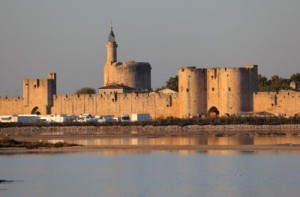
With an area of over 930 km² (360 sq. miles), the Camargue is western Europe’s largest river delta (technically an island, as it is wholly surrounded by water). It is a vast plain comprising large brine lagoons or étangs, cut off from the sea by sandbars and encircled by reed-covered marshes which are in turn surrounded by a large cultivated area.
Approximately a third of the Camargue is either lakes or marshland. The central area around the shoreline of the Étang de Vaccarès has been protected as a regional park since 1927, in recognition of its great importance as a haven for wild birds, and was incorporated into the Parc Régional de Camargue in 1972.
Regional Park
The Camargue is home to more than 400 species of birds, the brine ponds providing one of the few European habitats for the greater flamingo. The marshes are also a prime habitat for many species of insects, notably (and notoriously) some of the most ferocious mosquitos to be found anywhere in France. It is also famous for bulls and the Camargue horse.
The flora of the Camargue is specially adapted to cope with the saline conditions. Sea lavender and glasswort flourish along with tamarisks and reeds.
Officially established as a regional park and nature reserve in 1970, the Parc Régional de Camargue covers 820 km² that are some of the wildest and most protected in all of Europe. A roadside museum provides background on flora, fauna, and the history of the area.
Human influence
Humans have lived in the Camargue for millennia, greatly affecting it with drainage schemes, dykes, rice paddies and salt pans. Much of the outer Camargue has been drained for agricultural purposes. The Camargue has its own eponymous horse breed, the famous white Camaguais ridden by the gardians who rear the region’s fighting bulls for export to Spain, as well as sheep.
There are few towns of any size in the Camargue. Its “capital” is Arles, located at the extreme north of the delta where the Rhône forks into its two principal branches. The only other towns of note are Saintes-Maries-de-la-Mer, about 45 km to the southwest, which is the site of the annual Roma pilgrimage for the veneration of Saint Sarah, and the medieval fortress-town of Aigues-Mortes on the far western edge, in the Petite Camargue.
The Camargue was exploited in the Middle-Ages by Cistercian and Benedictine monks. In the XVI-XVIIth centuries, big estates, known locally as mas, were founded by rich landlords from Arles. At the end of the XVIIIth century, the Rhône was dyked up. In 1858, the building of the digue à la mer (dyke to the sea) achieved protection of the delta from erosion. The north of the Camargue is made of agricultural land. Main crops are cereals, grapevine and rice. Near the seashore, salt extraction started in the antiquity and was a source of wealth for the Cistercian “salt abbeys” of Ulmet, Franquevaux and Psalmody in the Middle Ages. Salt industry started in the XIXth century and big chemical companies such as Péchiney and Solvay founded the ‘mining’ city of Salin-de-Giraud.
The boundaries of the Camargue are constantly revised by the Rhône as it transports huge quantities of mud downstream – as much as 20 million m³ annually. Some of the étangs are in fact the remnants of old arms of the river. The general trend is for the coastline to move outwards. Thus Aigues-Mortes for instance – on the coast when it was built – is now some 5 km (3 miles) inland. The pace of change has been modified somewhat in recent years by man-made barriers, such as dams on the Rhône and sea dykes, but flooding remains a problem across the region.